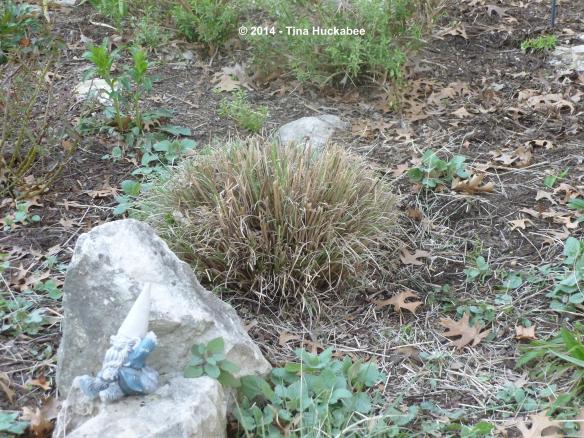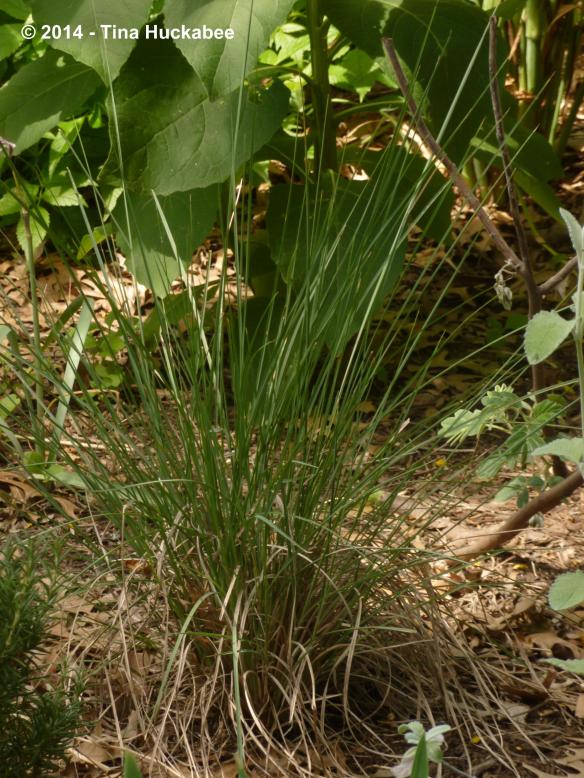This is the second post as part of the new and continuing series, A Seasonal Look. Today we’ll look at Lindheimer’s (Big) Muhly, Muhlenbergia lindheimeri .
Be still my beating heart! THAT is a beautiful plant!
The slender, graceful foliage in spring and summer and the fall/winter inflorescence of the Lindheimer’s or Big Muhly, Muhlenbergia lindheimeri, is eye-catching and always makes my heart skip a beat. My oh my!
Lindheimer’s Muhly is one of my favorite plants. (I know. I say that all the time.) I think it’s stunning year-round and a desirable garden addition–from its early spring-green strands of foliage growth,
through summer,
to the zenith of its beauty in fall.
Lindheimer’s Muhly is a native Texas grass. Endemic to Central Texas, it’s become a popular landscape plant for home and commercial gardens. L. Muhly is excellent in full sun and requires little water once established. It is a lovely ornamental grass and regionally appropriate for our gardens. Lindheimer’s Muhly is gorgeous when planted in pairs or groups,
or as a single specimen.
It’s a plant which adds structure, foliage interest and grace to any garden, whether in a mixed perennial bed or a desert-themed garden.
In most locally owned nurseries here in Central Texas, L. Muhly is available in four-inch, gallon and larger containers–depending upon the store and time of year. Lindheimer’s Muhly is an easy plant for the most neglectful gardener. The only maintenance is pruning the grass in late winter, preferably in February. Other than that, this plant requires little care. One other chore the gardener might undertake is to rake fallen leaves out of the grass after autumn leaf fall.
Personally, I don’t bother. But if you find fallen leaves tangled in the grass unattractive, it won’t hurt your Muhly to rake them out. Go for it!
As for pruning Lindheimer’s Muhly, all that’s required is pruning straight across in a “buzz” cut or pruning into a rounded shape. You can use hand pruners or larger lopping pruners. I have an old, electric pruner and I simply let’r rip–it takes about 30 seconds for me to prune a mature plant. That’s it!
Here are some examples of L. Muhly after winter “hair” cuts.
An advantage of pruning in late February versus early January ( well after the typical first hard freeze renders the plant dormant), is that pruning in February results in only days or weeks before new growth begins. A week or two after pruning, the new spring growth visibly arches up and over the pruned portion of the grass.

Also, it’s a good idea to plant L. Muhly with early to mid spring blooming perennials or native annual spring wildflowers. I’ve planted mine with Heartleaf Skullcap, Purple Coneflower and iris as neighboring companion plants. As the Muhly is growing from its winter prune, the blooming annuals and perennials can flower with abandon and strut their stuff. Later in summer and fall, when the Muhly is in its full glory, the earlier spring bloomers have exited center stage–either by complete dormancy (like Heartleaf Skullcap) or reverting to a less showy, non-blooming state.
It’s not necessary to prune Muhly–after all, in the wild they aren’t pruned. I experimented a couple of years ago with one of my Muhly grasses and didn’t prune in late winter. Here it is in spring:
and in the early summer:
I eventually selectively pruned the dead foliage out of the plant because I preferred the newer green growth to dominate and considering that my Muhlies are in a cultivated garden, it’s appropriate to “neaten” them with a late winter trim. Pruning isn’t necessary for the health of the plant–pruning is for aesthetics only.
Lindheimer’s Muhly is deer resistant and will get two to five feet tall and about three feet wide. L. Muhly prefers full sun, though it can take some shade. It can also grow in a variety of soil types, though as it’s native to the Edwards Plateau eco-region, it prefers a rockier soil. The two original Muhly plants in my gardens succumbed to increasing shade, plus the soil in my garden is somewhat heavy. My property lies along a junction of the Edwards Plateau and the Blackland Prairie eco-regions and is the heavier Blackland Prairie soil. The combination of increasing shade and clay soil is not ideal for L. Muhly. Last year, one Muhly rotted out completely and the other was well on its way. I removed both, but added two more L. Muhlies to the garden.
I replaced the two rotted Muhlies with new, one gallon-sized plants in fall 2013. Seedlings and newly purchased specimens are easy to plant–just water for the first few weeks, then back off of the irrigation. Mature L. Muhly require minimal irrigation. I water one or twice per month during the summer months. Also, I don’t mulch my Muhlies thickly–a thin covering is fine.
The replacement Muhly grasses receive more sun than the originals–they should be happier.
Try Lindheimer’s (Big) Muhly in your garden. It’s hard to find a plant that requires less maintenance than this magnificent ornamental native grass.
In spring,
summer,
fall,
and winter,
you’ll be happy with your choice!





















Thank you for this. Last year I planted some skullcap for the first time in a section that actually gets some light. It is slowly filling out the space and I am thrilled with its easy care but I was thinking it needed some kind of companion to grow alongside it. I am grateful to see how you show the year long progression. What is up with plants that capture leaves in winter? I sometimes clean them out but most often don’t bother. Is it an accident or do you think it has some kind of purpose – maybe providing habitat for small things or collecting carbon to decompose during the spring rain. I don’t know but I am always torn between being neat and letting things go with the flow.
LikeLike
Like you, I’m always torn with the choice of being tidy or not. It really depends on how busy I am. I think the cycle of decomposition is simply what happens and those leaves would eventually decompose as they do without our help, in nature. In our “yards” though, we want to control the outcome–I guess it’s a thing people do. 🙂 I’ve learned the hard way to really think about companion planting, otherwise my gardens have blank areas. I think that just takes time and experience. Good luck with your skullcap and thanks for dropping by!
LikeLike
I really appreciate the tip. Thanks.
LikeLike
Fabulous. This post is a gift. I truly appreciate getting to see the plant’s appearance year ’round, and in different size stages. That’s something you don’t get at the nursery. In attempt to interrupt impulsive plant placement disasters, I’ve been considering where to put one of those Big Muhlys here for several months now. This post helped me decide to put one on my list for a Fall buyandplant marathon. I’ll pay closer attention to how much sun the proposed site is getting and think about companion plantings as well. Ah, the luxury of time! Looks like there is something to this thoughtful approach after all!
LikeLike
I’m glad you’re going to plant-don’t you hate that you’ll have to wait until fall?? I wish I had more room and sun for muhly, but I’m grateful for what they do in my gardens. Enjoy all the planning time you have in front of you!
LikeLike
This grass is greatly under-rated by too many people, and I’m happy to see you show it off in so many different ways.
I’m a great fan of grass heads by setting sun, myself — nothing better on Earth to look at, especially in a desert.
Like this:
You’ve got a lot more, and lot better views than I’ve posted. Thanks.
LikeLike
Oops. Here’s the link: timpanogos.wordpress.com/2013/04/23/remembering-lindheimers-muhly-grass-from-last-years-garden/
LikeLike
Thanks for stopping in, Ed. You’re right that the native Texas grasses are underutlized-more gardeners should plant them. Thanks for helping to spread the word.
LikeLike
I love your “seasonal look” posts–it’s such a valuable education to see what a plant looks like in every season, and not just the showy one(s). I’m thinking this might be a perfect addition to our parking strip–how big does it get?
Thanks!
LikeLike
I Mary–sorry for the delay in responding. I’ve been in Oregon (sigh, so beautiful. And cool.) and for some reason, your comment didn’t appear in my email. Hmm, I’ll need to check that. Anyway, if your parking strip is in full sun, the L. Muhly would be perfect. My muhlies get about 3 feet wide and about as tall, though a little taller with the fall spikes. The other grasses and smaller yuccas are also lovely in that kind of situation. Let me know what you decide to do.
LikeLike
Pingback: Native Season | My Gardener Says…
Pingback: Symmetry | My Gardener Says…
Pingback: Autumn Natives | My Gardener Says…